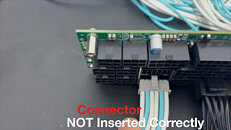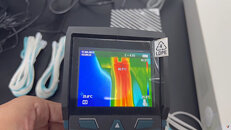TheLostSwede
News Editor
- Joined
- Nov 11, 2004
- Messages
- 18,624 (2.48/day)
- Location
- Sweden
| System Name | Overlord Mk MLI |
|---|---|
| Processor | AMD Ryzen 7 7800X3D |
| Motherboard | Gigabyte X670E Aorus Master |
| Cooling | Noctua NH-D15 SE with offsets |
| Memory | 32GB Team T-Create Expert DDR5 6000 MHz @ CL30-34-34-68 |
| Video Card(s) | Gainward GeForce RTX 4080 Phantom GS |
| Storage | 1TB Solidigm P44 Pro, 2 TB Corsair MP600 Pro, 2TB Kingston KC3000 |
| Display(s) | Acer XV272K LVbmiipruzx 4K@160Hz |
| Case | Fractal Design Torrent Compact |
| Audio Device(s) | Corsair Virtuoso SE |
| Power Supply | be quiet! Pure Power 12 M 850 W |
| Mouse | Logitech G502 Lightspeed |
| Keyboard | Corsair K70 Max |
| Software | Windows 10 Pro |
| Benchmark Scores | https://valid.x86.fr/yfsd9w |
Hardware Busters put the new 12V-2x6 connector—which is part of the ATX v3.1 standard—to the test to see how it compares to the 12VHPWR connector and the results are very encouraging. Not only does the 12V-2x6 cables appear to run at much cooler temperature, even at a 55 Ampere load, although the setup that was tested had only been running at this load for around 30 minutes. Even so, the cable and connector was only reading a surface temperature of around 46 degrees, which is well within specs.
However, to show that the new connector wouldn't suffer the catastrophic failure that some 12VHPWR connectors have suffered due to not having been mated properly with the connector on the graphics card, the same test was also performed with the connector partially inserted. Based on the test equipment shown in the video, there was no variation in Voltage, Amps or temperature. The specific cable was produced by a company in China called Linewell that apparently makes the PSU cables for ASUS among others. The secret behind the improved connector is a combination of new pins inside the connector and the shorter auxiliary pins which means that a poorly inserted connector won't allow the GPU to request higher power levels from the PSU. The new pins inside of the connectors appear to be solving the thermal issues as well, so hopefully we won't be reading about any more melted connectors in the future. See the video after the break for more details.


View at TechPowerUp Main Site | Source
However, to show that the new connector wouldn't suffer the catastrophic failure that some 12VHPWR connectors have suffered due to not having been mated properly with the connector on the graphics card, the same test was also performed with the connector partially inserted. Based on the test equipment shown in the video, there was no variation in Voltage, Amps or temperature. The specific cable was produced by a company in China called Linewell that apparently makes the PSU cables for ASUS among others. The secret behind the improved connector is a combination of new pins inside the connector and the shorter auxiliary pins which means that a poorly inserted connector won't allow the GPU to request higher power levels from the PSU. The new pins inside of the connectors appear to be solving the thermal issues as well, so hopefully we won't be reading about any more melted connectors in the future. See the video after the break for more details.


View at TechPowerUp Main Site | Source










